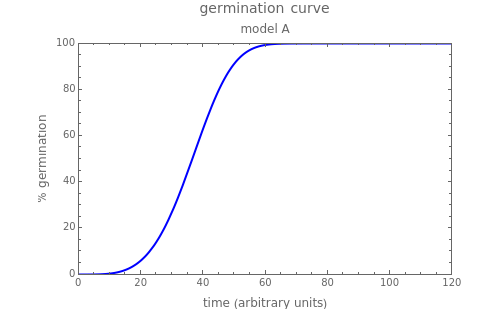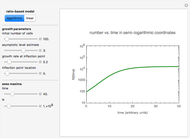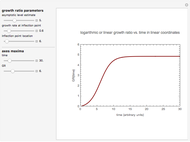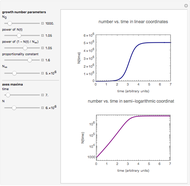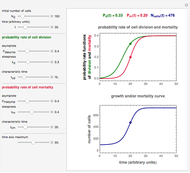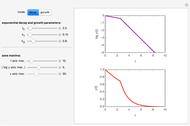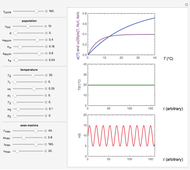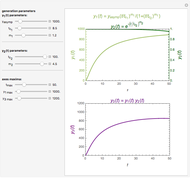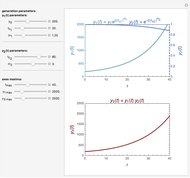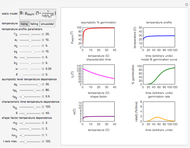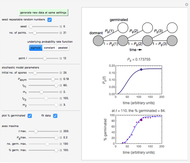Isothermal Germination of Seeds and Microbial Spores

Requires a Wolfram Notebook System
Interact on desktop, mobile and cloud with the free Wolfram Player or other Wolfram Language products.
A germination curve is a plot of the percent of sprouted plant seeds or fungal or bacterial spores as a function of time. Typically, an isothermal germination curve has a sigmoid shape that can be represented by various phenomenological mathematical models whose parameters are the asymptotic germination level  , a characteristic time marker
, a characteristic time marker  , and a shape or rate factor
, and a shape or rate factor  representing the curve’s steepness or span. This Demonstration shows isothermal germination curves for two models and different combinations of their parameters.
representing the curve’s steepness or span. This Demonstration shows isothermal germination curves for two models and different combinations of their parameters.
Contributed by: Mark D. Normand and Micha Peleg (June 2013)
Open content licensed under CC BY-NC-SA
Snapshots
Details
Snapshot 1: symmetric germination curve with a short lag produced with model A
Snapshot 2: asymmetric germination curve with a short lag produced with model B
Snapshot 3: symmetric germination curve with a long lag produced with model A
Snapshot 4: asymmetric germination curve with a long lag produced with model B
Snapshot 5: incomplete germination curve produced with model A
Snapshot 6: non-sigmoid germination curve produced with model B
The sprouting of seeds plays a major role in agriculture, and the germination of bacterial, yeast, and fungal spores is important in food safety, food processing, and medicine. Although the physiological mechanisms that regulate them are very different, their kinetics typically results in a sigmoid germination curve reminiscent of a growth curve. Consequently, several mathematical growth models [1], noticeably the Gompertz, Weibull, and versions of the logistic equation, have also been used to characterize germination curves.
This Demonstration shows different germination patterns by generating germination curves with two models. Model A (Weibull):  and model B [2]:
and model B [2]:  , where
, where  is the percent of germinated seeds or spores at time
is the percent of germinated seeds or spores at time  (
( ),
),  is the asymptotic germination level in percent,
is the asymptotic germination level in percent,  is the characteristic time in arbitrary units, and
is the characteristic time in arbitrary units, and  (
( ) is a dimensionless shape factor controlling the germination curve’s steepness or span.
) is a dimensionless shape factor controlling the germination curve’s steepness or span.
Both models satisfy the initial condition  and produce a sigmoid curve when
and produce a sigmoid curve when  . They differ primarily in that model B tends to produce germination curves that are more skewed to the right. Also, in model A,
. They differ primarily in that model B tends to produce germination curves that are more skewed to the right. Also, in model A,  , while in model B,
, while in model B,  . The inflection point according to model A is at
. The inflection point according to model A is at  , and for model B it is at
, and for model B it is at  .
.
Choose the germination model by clicking a setter bar. Enter the three germination parameters' values,  ,
,  , and
, and  , with sliders. You can also enter the germination duration with a slider that controls the upper limit of the time axis.
, with sliders. You can also enter the germination duration with a slider that controls the upper limit of the time axis.
References
[1] X. Yin, J. Goudriaan, E. A. Lantinga, J. Vos, and H. J. Spiertz, "A Flexible Sigmoid Function of Determinate Growth," Annals of Botany, 91(3), 2003 pp. 361–371. aob.oxfordjournals.org/content/91/3/361.full.pdf+html.
[2] P. Dantigny, S. P.-M. Nanguy, D. Judet-Correia, and M. Bensoussan, "A New Model for Germination of Fungi," International Journal of Food Microbiology, 146(2), 2011 pp. 176–181. www.sciencedirect.com/science/article/pii/S0168160511001012.
Permanent Citation
